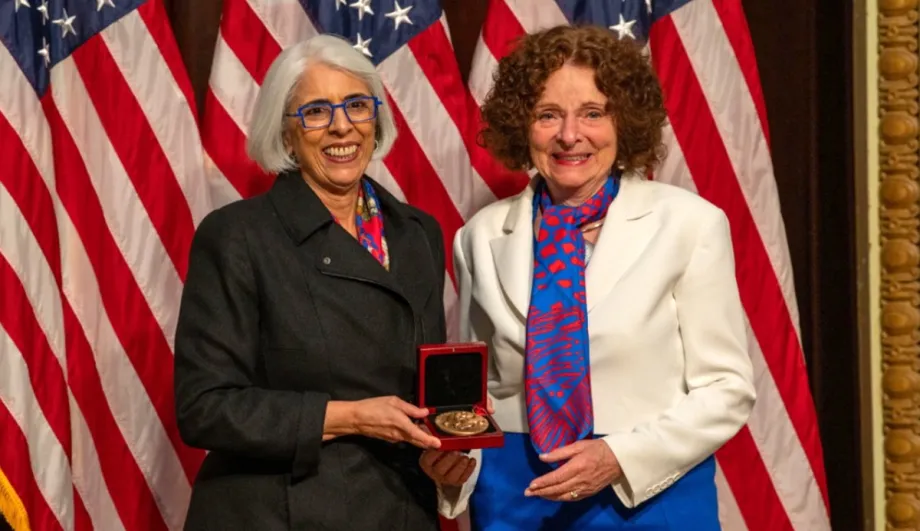
Arati Prabhakar, director of the White House Office of Science and Technology Policy, awards Helen M. Blau the National Medal of Science during a ceremony at the Eisenhower Executive Office Building in Washington, D.C. | Ryan K. Morris and the National Science and Technology Medals Foundation
Stanford Report - January 12th, 2025
Helen Blau, professor of microbiology and immunology and director of the Baxter Laboratory for Stem Cell Biology, had an exciting start to 2025. On Jan. 3, Blau was awarded the National Medal of Science by President Biden at the White House for her work on cellular plasticity – a term describing how specialized cells in the body aren’t fixed in their identity but instead can be coaxed to assume new roles – and her discoveries concerning the biological mechanisms of stem cells, tissue regeneration, aging and rejuvenation of weakened muscles.
“Dr. Blau’s role in advancing knowledge in the fields of regenerative medicine and aging is remarkable,” said Lloyd Minor, MD, the dean of the Stanford School of Medicine and vice president for medical affairs at Stanford University. “Beyond these achievements, she is well-known as an innovator and a dedicated mentor to younger scientists. Stanford Medicine is proud and happy that she has been recognized as one of the country’s most impactful scientists.”
Established by Congress in 1959, the National Medal of Science is the highest recognition the nation can bestow on scientists and engineers. The presidential award is given to individuals deserving of special recognition for their outstanding contributions to knowledge in several scientific fields including biological, physical and social sciences; mathematics; and engineering.
Blau’s early discovery of the plasticity of mature cells flew in the face of prevailing scientific dogma. The realization that specialized, or differentiated, cells are malleable was foundational for subsequent advances in stem cell-based therapies and regenerative medicine around the world. Her lab used this approach to target Duchenne muscular dystrophy and aging-related loss of muscle strength.
“The idea that discoveries in my lab can be translated to clinical therapies to help people is the most gratifying feeling in the world,” said Blau, who is the Donald E. and Delia B. Baxter Foundation Professor. “Being recognized with the National Medal of Science for my work is an amazing, unexpected honor.”
Blau’s most recent research focuses on inhibiting the activity of a new class of molecule she terms a “gerozyme,” or master regulator of aging. Gerozymes cause muscle wasting in mice, and blocking their activity in muscle tissue of old mice increases muscle strength. This finding holds promise for people with muscle weakness due to lack of use, genetic disease, or age.
“I’m thrilled that Helen has been awarded the 2025 National Medal of Science, a truly well-deserved honor!” said Denise Monack, PhD, chair of the Department of Microbiology and Immunology and the Martha Meier Weiland Professor in the School of Medicine. “Her groundbreaking work in regenerative medicine, through innovative and cross-disciplinary methods, has unraveled key mechanisms affecting muscle stem cell functionality in conditions like dystrophy and aging. Her pioneering discovery of a novel aging-associated enzyme has opened pathways to rejuvenating aged muscle tissue and enhancing strength via pharmacological methods. I’m counting on Helen’s new drug to sustain the vitality and strength of the microbiology and immunology faculty for years to come.”
Blau, who is also a prolific inventor, recently authored a children’s book, Stem Cells to the Rescue, to teach children, their parents, and their grandparents the biological basics of these versatile cells. She didn’t grow up in a family of scientists: Her father was a historian, and her mother taught comparative literature. But they were quick to support their daughter’s dreams.
Young scientist
“I’ve always been curious about how things function,” Blau said. When, as a child, Blau found a portion of an animal skull in the woods near her home in Heidelberg, Germany, her parents orchestrated her access to the University of Heidelberg’s library so she could research its origin. Her conclusion that the teeth were those of a red deer doe garnered a first-place win in her school’s science fair when she was 11. Her interest in tissue regeneration was piqued when, as an undergraduate student at the University of York, she studied the effect of thyroid hormone on mitochondria during liver regeneration. The liver is unique among organs in its ability to regenerate when a portion is surgically removed. “We could remove the large lobes of the liver, and the smaller lobes would become larger,” Blau said. “But they somehow knew when they’d reached their final mass and when to stop. It is a fascinating mystery we still haven’t solved.”
After completing a doctorate in biology at Harvard followed by a postdoctoral position at the University of California, San Francisco, Blau arrived at Stanford University in 1978 as an assistant professor of pharmacology in the School of Medicine – becoming one of the first women to be hired on the tenure track in the basic sciences. (The other was Carla Shatz, PhD, professor of biology and of neurobiology and the Sapp Family Provostial Professor. Shatz was the director of Stanford Bio-X.)
“I think it was an experiment; people were watching to see how we did,” Blau said, in a video conversation between her and Shatz. Blau decided not to do “things the way that everyone else did, but to take a different direction and think in a nontraditional way.”
It was early in her career at Stanford Medicine that Blau performed a key set of cell fusion experiments between human skin, connective tissue or liver cells, and mouse muscle cells that showed the flexibility of differentiated cells.
“After fusion, the human cells began to make muscle-specific gene products,” Blau said. “This challenged the idea that differentiated cells were irreversibly fixed in their fate and showed that a shift in the balance of proteins in the nucleus can reprogram a cell to become a different type of cell.” She conducted the work while she was an assistant professor; it was featured on the cover of the journal Science under the banner “Frontiers in Biology” in 1985. These results set the stage for the discovery induced pluripotent stem cells decades later.
Subsequent research by Blau and others revealed the roles played by tissue-specific stem cells in tissue regeneration. In 2008, Blau was the first to isolate and characterize muscle stem cells using flow cytometry and bioluminescence imaging. She showed that these cells lost their “stemness” on typical tissue culture plastic but overcame this hurdle by cultivating them on a substrate that mimics the elasticity of healthy young muscle. The finding that stem cells maintained their ability to both self-renew and differentiate into more specialized muscle cells defined a key aspect of stem cell function. Understanding the critical relationship between substrate stiffness and stem cell function enabled researchers to maintain and study other tissue stem cells outside of the body.
In 2014, Blau’s lab showed that muscle stem cell function declines during aging due in part to cell-intrinsic internal defects, including an age-dependent increase in a molecule called CD47 on the surface of the cells. Blocking this increase in laboratory mice led to a significant increase in muscle strength after injury. And in 2017 Blau made the landmark discovery that prostaglandin E2, a metabolite that is part of the natural healing mechanism, is essential to muscle stem cell function, promoting viability and proliferation. In 2021, Blau’s lab identified a molecule called 15-PGDH, which degrades prostaglandin E2, as the first gerozyme in mice. “One month of treatment with a small molecule drug that blocks 15-PGDH activity in the muscles of old mice augments the animals’ muscle mass and strength by 15%,” Blau said. A phase 1 clinical trial testing the drug in people has recently been approved by the U.S. Food and Drug Administration.
“The underlying theme of my work has been cell plasticity, the potential for change, and we are now showing that muscle rejuvenation even in aging is possible,” Blau said. “We’ve shown this in muscle tissue, and we expect it to be applicable to other tissue types as well.”
In December, Blau was traveling in Japan with her family when she received a call from White House staff informing her she would be awarded the National Medal of Science in early January. “They swore us to secrecy, and we didn’t know who any of the other recipients were,” Blau said.
During the Jan. 3 ceremony – which also recognized individual and organizational recipients of the National Medal of Technology and Innovation – she and her husband, David Spiegel, MD, the associate chair of psychiatry and behavioral sciences and the Jack, Lulu and Sam Willson Professor in Medicine, mingled with researchers involved in the development of the gene editing technique CRISPR, the mRNA-based vaccines for SARS-CoV-2, and the cell phone and its camera.
“It was amazing,” Blau said. “These are world-changing advances. It was fabulous to be included.”
Asked for advice for younger scientists, Blau said, “Pursue your dreams, enjoy what you’re doing. Take risks and think big – avoid ‘me too’ science. Challenge ideas and work outside the box. Above all, you have to be passionate about what you do.”
Blau is a member of Bio-X, the Stanford Cancer Institute, the Stanford Cardiovascular Institute, the Stanford Maternal and Child Health Research Institute, the Wu Tsai Neurosciences Institute, and the Wu Tsai Human Performance Alliance.

